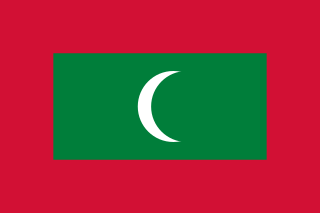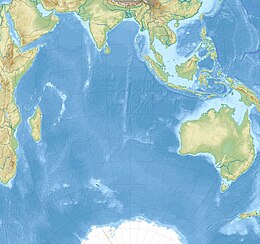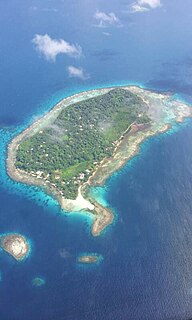 Satellite image of the Maldive Islands | |
| Geography | |
|---|---|
| Location | Indian Ocean |
| Coordinates | 3°12′N73°13′E / 3.20°N 73.22°E Coordinates: 3°12′N73°13′E / 3.20°N 73.22°E |
| Total islands | 1190 |
| Administration | |
The Maldive Islands is a group of islands in the Indian Ocean composing today's Republic of Maldives and the island of Minicoy in the Union Territory of Lakshadweep of India.

The Indian Ocean is the third-largest of the world's oceanic divisions, covering 70,560,000 km2 (27,240,000 sq mi). It is bounded by Asia on the north, on the west by Africa, on the east by Australia, and on the south by the Southern Ocean or, depending on definition, by Antarctica.

The Maldives, officially the Republic of Maldives, is a small country in South Asia, located in the Arabian Sea of the Indian Ocean. It lies southwest of Sri Lanka and India, about 1,000 kilometres (620 mi) from the Asian continent. The chain of 26 atolls stretches from Ihavandhippolhu Atoll in the north to Addu Atoll in the south. Comprising a territory spanning roughly 298 square kilometres (115 sq mi), the Maldives is one of the world's most geographically dispersed sovereign states as well as the smallest Asian country by land area and population, with around 427,756 inhabitants. Malé is the capital and the most populated city, traditionally called the "King's Island" for its central location.

Minicoy, locally known as Maliku is an island in Lakshadweep, India. Along with Viringili, it is on Maliku atoll, the southernmost atoll of Lakshadweep archipelago. Administratively, it is a census town in the Indian union territory of Lakshadweep.
Historically Minicoy was within the domain of the sultans of the Maldives. In 1790 Minicoy was surrendered to the Court of Directors of the East India Company and thus became part of the territory of the Madras presidency of British India. [1] In 1858, following the Indian Mutiny of 1857, the control of British India transferred from the East India Company to the British Crown, and a decade later Queen Victoria was proclaimed empress. [2]

Sultan is a position with several historical meanings. Originally, it was an Arabic abstract noun meaning "strength", "authority", "rulership", derived from the verbal noun سلطة sulṭah, meaning "authority" or "power". Later, it came to be used as the title of certain rulers who claimed almost full sovereignty in practical terms, albeit without claiming the overall caliphate, or to refer to a powerful governor of a province within the caliphate. The adjective form of the word is "sultanic", and the dynasty and lands ruled by a sultan are referred to as a sultanate.

The East India Company (EIC), also known as the Honourable East India Company (HEIC) or the British East India Company, and informally known as John Company, Company Bahadur, or simply The Company, was an English and later British joint-stock company. It was formed to trade in the Indian Ocean region, initially with Mughal India and the East Indies, and later with Qing China. The company ended up seizing control over large parts of the Indian subcontinent, colonised parts of Southeast Asia, and colonised Hong Kong after a war with Qing China.
The Crown is the state in all its aspects within the jurisprudence of the Commonwealth realms and their sub-divisions. Legally ill-defined, the term has different meanings depending on context. It is used to designate the monarch in either a personal capacity, as Head of the Commonwealth, or as the king or queen of his or her realms. It can also refer to the rule of law; however, in common parlance 'The Crown' refers to the functions of government and the civil service.
The Maldive Islands became a British protectorate in 1887. [3] At the time of the partition of India of 1947, Minicoy transferred automatically to the new Union of India, while the remainder of the Maldives continued as a self-governing sultanate, under the status of British protection, ultimately achieving full independence in 1965. [3]
British protectorates were territories over which the British government exercised only limited jurisdiction. Many territories which became British protectorates already had local rulers whom the Crown negotiated with through treaty, acknowledging their status whilst simultaneously offering protection. British protectorates were therefore governed by indirect rule. In most cases, the local ruler, as well as the subjects of the ruler, were not British subjects.

The Partition of India was the division of British India in 1947 which accompanied the creation of two independent dominions, India and Pakistan. The Dominion of India is today the Republic of India and Dominion of Pakistan, the Islamic Republic of Pakistan and the People's Republic of Bangladesh. The partition involved the division of two provinces, Bengal and the Punjab, based on district-wise Hindu or Muslim majorities. It also involved the division of the British Indian Army, the Royal Indian Navy, the Indian Civil Service, the railways, and the central treasury, between the two new dominions. The partition was set forth in the Indian Independence Act 1947 and resulted in the dissolution of the British Raj, or Crown rule in India. The two self-governing countries of India and Pakistan legally came into existence at midnight on 14–15 August 1947.
Linguistically, Minicoy remains linked to the rest of the island group.










